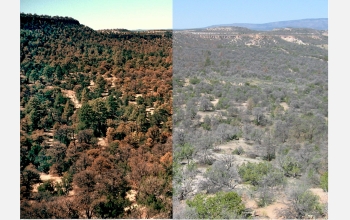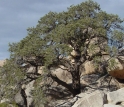News Release 05-182
Heat and Drought Kills Trees in Southwest
Study sheds light on how quickly vegetation may respond to climate change

These photos show the massive die-off of pinyon pines that occurred during a recent drought.
October 11, 2005
This material is available primarily for archival purposes. Telephone numbers or other contact information may be out of date; please see current contact information at media contacts.
According to newly published research, a massive die off of pinyon trees throughout the Southwest was caused by higher atmospheric temperatures combined with drought and lowered pest resistance.
While the trees ultimately succumbed to infestations of bark beetles, "it was the drought," said research team leader David Breshears, a biologist at the University of Arizona. "Beetles don't get trees unless the trees are really water-stressed" and unable to make enough pinesap to defend themselves against the insects, he said.
Breshears, Neil Cobb, director of the Merriam-Powell Center for Environmental Research at Northern Arizona University in Flagstaff, Paul Rich, research scientist at Los Alamos National Laboratory (LANL) in N.M. and their colleagues reported their findings this week in the online Early Edition of the Proceedings of the National Academy of Sciences.
In 1987, researchers established a study site in the pinyon-juniper woodland zone at LANL in northern N.M. They measured moisture and temperature of the location and used satellites to determine the extent of tree cover, according to Alan Tessier, program director in the National Science Foundation's division of environmental biology, which co-funded the research with several federal agencies.
The region's 60,000 square miles (about 155,000 square km) of pinyon-juniper woodlands became a lot less green starting in 2002, the team found. By the end of 2003, more than 90 percent of the pinyons in the study plot were dead.
Breshears says such higher temperatures and drought are of the type predicted by climate-change models.
The National Science Foundation (NSF), Los Alamos National Laboratory (LANL), the U.S. Forest Service, the U.S. Geological Survey, NASA and the National Institutes of Health funded the research.
-NSF-
-
Pinyons throughout the Southwest suffered a die-off after a long period of heat and drought.
Credit and Larger Version
Media Contacts
Cheryl Dybas, NSF, (703) 292-7734, email: cdybas@nsf.gov
Mari Jensen, University of Arizona, (520) 626-9635, email: mnjensen@email.arizona.edu
Related Websites
University of Arizona's Press Release: http://uanews.org/cgi-bin/WebObjects/UANews.woa/10/wa/SRStoryDetails?ArticleID=11731
The U.S. National Science Foundation propels the nation forward by advancing fundamental research in all fields of science and engineering. NSF supports research and people by providing facilities, instruments and funding to support their ingenuity and sustain the U.S. as a global leader in research and innovation. With a fiscal year 2023 budget of $9.5 billion, NSF funds reach all 50 states through grants to nearly 2,000 colleges, universities and institutions. Each year, NSF receives more than 40,000 competitive proposals and makes about 11,000 new awards. Those awards include support for cooperative research with industry, Arctic and Antarctic research and operations, and U.S. participation in international scientific efforts.
Connect with us online
NSF website: nsf.gov
NSF News: nsf.gov/news
For News Media: nsf.gov/news/newsroom
Statistics: nsf.gov/statistics/
Awards database: nsf.gov/awardsearch/
Follow us on social
Twitter: twitter.com/NSF
Facebook: facebook.com/US.NSF
Instagram: instagram.com/nsfgov



